Emerald THE DAILY
TUESDAY, JAN. 7, 2025
Flu season is here and does not only affect humans
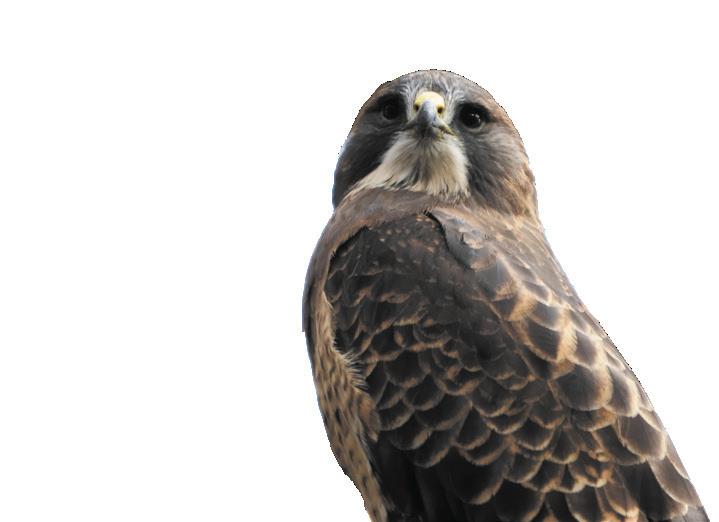
UO unions look ahead to winter term mediations with UO


TUESDAY, JAN. 7, 2025
Flu season is here and does not only affect humans

UO unions look ahead to winter term mediations with UO


An inside look at McKenzie River Music, a Eugene-based guitar shop known for its blend of vintage and modern instruments, expert staff and commitment to fostering the local music community
Buckeyes level Oregon’s defense in 111th Rose Bowl

Akpakwu sat down with the Daily Emerald to talk about her and ASUO’s plans for the remainder of the academic year
By Stephanie Jersey Campus News Reporter
In an interview with the Daily Emerald, Kikachi “Kiki” Akpakwu, the Vice President of the Associated Students of the University of Oregon, answered a series of questions, which all centered around her and ASUO’s plans for the remaining five months of the 2024-2025 academic year.
ASUO is made up of over 25 elected students. “From helping set the Incidental-Fee, allocating See pg 10 for story
By Jackson Buckley Arts & Culture Writer
When it comes to brick-and-mortar stores, few feelings come to mind that compare to walking into a music store and being surrounded by beautiful instruments. When entering McKenzie River Music, one is immersed in a haven of guitars that decorate both sides of the walls from top to bottom. Some of the instruments have been recently made, while some
originate from before World War II. The store’s inventory ranges from Gibson, Fender, Martin, Taylor and vintage guitars, along with plenty of products for musicians to take care of their instruments.
Located on West 11th Avenue in Eugene, McKenzie River Music is a place for all levels of guitar players to find quality products to fit their musical needs. The store was orig
By Sasha Love Campus News Reporter
During the fall term, the University of Oregon hosted 825 international students from 93 countries, according to UO’s website. These students could be especially impacted by the incoming Trump administration and proposals in Project 2025, leading to some feeling “concerned” and searching for campus resources.
In a Dec. 8 interview with NBC’s “Meet the Press,” incoming President-elect Donald Trump implied he plans on deporting all immigrants who are in the United States illegally, prioritizing those with any criminal histories. Though not officially endorsed by Trump, Project 2025, a Republican
See pg 4 for story
City planners emphasize the importance of a new protected intersection in reducing the risk of crashes
By Joseph Chiu City News Associate Editor
Eugene locals and visitors alike are driving into new territory in the new year after the completion of River Road’s “protected” intersection.
Construction on the River Road intersection at Irving Road and Hunsaker Lane was completed in late November 2024, nearly two years after it was originally set to be completed. The renovation made it the first protected intersection in Eugene and was implemented to address concerns regarding the safety of drivers, bicyclists and pedestrians

EDITOR IN CHIEF
Tristin Hoffman
PRINT MANAGING EDITOR
Mathias Lehman-Winters
DIGITAL MANAGING EDITOR
Alicia Santiago
CAMPUS NEWS EDITOR
Jasmine Saboorian
CITY NEWS EDITOR
Mathias Lehman-Winters
INVESTIGATIONS EDITOR
Tarek Anthony
A&C EDITOR
Jess McComb
SPORTS EDITOR
Brady Ruth
OPINION EDITOR
Beatrice Byrd
PHOTO EDITOR
Molly McPherson
COPY CHIEF
Olivia Ellerbruch
COPY EDITOR
Alex Woodward
VIDEO EDITOR
Kendall Baldwin
PODCAST EDITOR
Evan Giordano
SOCIALS EDITOR
Sydney Wolfe
VISUALS EDITOR
Noa Schwartz
DESIGN EDITOR
Sam Butler
DESIGNERS
Eva Andrews
Adaleah Carman
Gabriela Martinez Contreras
Olivia Hoskinson
Peyton McQuain
Bella Lyon
PUBLISHER AND PRESIDENT
Eric Henry (X317) ehenry@dailyemerald.com
VP OPERATIONS
Kathy Carbone (X302) kcarbone@dailyemerald.com
DIRECTOR OF SALES & DIGITAL MARKETING
Shelly Rondestvedt (X303) srondestvedt@dailyemerald. com
CREATIVE & TECHNICAL DIRECTOR
Anna Smith (X327) creative@dailyemerald.com
STUDENT SALES MANAGER
Lola Tagwerker
ACCOUNT EXECUTIVES
Cooper Gast
Elliot Byrne
Ysai Hong
Nate Ghilarducci
THE DAILY
The Daily Emerald is published by Emerald Media Group, Inc., the independent nonprofit media company at the University of Oregon. Formerly the Oregon Daily Emerald, the news organization was founded in 1900.
The Rose Bowl sun set on the Ducks’ remarkable season
By Joe Krasnowski Sports Reporter
Sports often produce some of the best underdog stories. We gravitate to them with ease and cherish them while they last. But the not-so-secret truth about it all is that nothing beats the innate desire to watch and witness greatness.
The Ducks’ (13-1) quest for greatness — and perfection — ended in unremark-

The former Fraternity and Sorority Life Assistant Director was previously placed on administrative leave after posting a video on Instagram telling Trump Supporters to “jump off a f— king bridge”
By Angelina Handris Campus News Reporter
On Dec. 20, former University of Oregon Fraternity and Sorority Life leader Leonard Serrato announced in an Instagram video obtained by the Daily Emerald that he had been terminated from his position as assis-
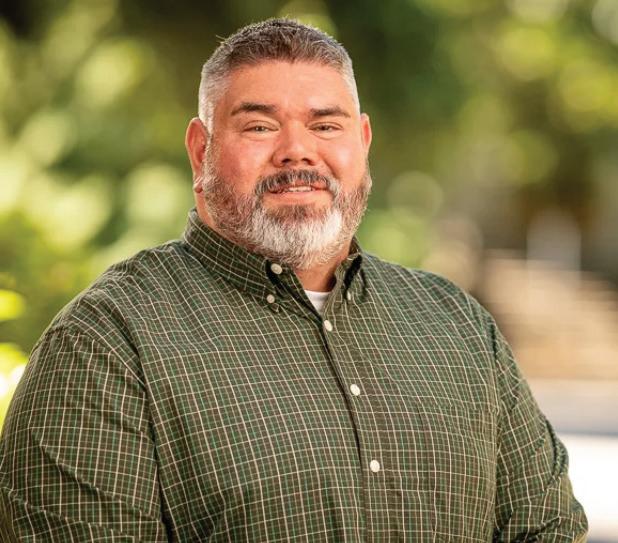
A detailed overview of clubs at the University of Oregon from its members through its appeals and challenges
Emerald Media Group 1395 University St.,#302 Eugene, Or 97403 (541)-346-5511


By Annie Biondello Campus News Reporter
The University of Oregon has more than 400 clubs, ranging from sports to business-oriented organizations.
In interviews with the Daily Emerald, several campus club members shared their perspectives on what it’s like to run a club and the struggles of their clubs.

Johnson, at the age of 95, was still a vital contributor to the local alternative weekly newspaper, the Eugene Weekly, and continued to promote the importance of investigative journalism throughout her life
By Daily Emerald
Anita Holmes Johnson, a visionary, lifelong journalist, co-owner of the Eugene Weekly and a former Daily Emerald editor-in-chief in 1951, died last month. She was 95.
Johnson graduated from the University of Oregon in 1953. During her time at UO, she held the Emerald’s highest position as its editor-in-chief, and within this role she challenged injustices across campus through her frequent editorials. She most notably reported on a group of men who burned a cross in front of the Gamma Phi Beta sorority because Deb Mohr, a sorority member, was dating DeNorval Unthank Jr., a Black man.
Her editorial on the matter, “The Code of Prejudice at Oregon,” received adverse reactions from UO admin. This didn’t stop her reporting or her editorials that would follow.
“No longer is there a place for those of us who are prone to overlook such discrimination although we believe it is wrong” Johnson wrote in her editorial published on May 17, 1951. “Principles today need more than lip service.”
Immediately following her time at the Emerald, Johnson reported for the Washington Post, with an assignment to cover engagements, weddings and more on the “women’s desk.” She and her husband, Art Johnson, later returned to Eugene.
Years later, Johnson co-founded the Eugene Weekly in 1991 with journalist and University of Oregon alumnus Fred Taylor. According to the Weekly, Johnson’s commitment to investigative and watchdog journalism never faltered.
In 2021, well into her 90s, Johnson was named one of the 15 most influential journalists in the United States over 50 years old by Editor & Publisher magazine.
“Ask the second question, which is probably the question your subject does not want to answer, so go after it,” Johnson said in her interview with Editor & Publisher. “Do not talk down to your readers. They will recognize it immediately and will be offended. Be passionate about your work and have some fun doing it.”
Project 2025 targets international, Dreamer and undocumented students, prompting a search for resources
blueprint reimagining the government’s responsibilities, backs up this message and spells out the logistics.
Though it is unknown what will come to fruition, some international students say they are concerned.
“What worries me sometimes is knowing how people will treat me knowing where I’m from because I’m from Mexico and everyone knows Trump hates Mexicans … so if I tell them where I’m from people might be more biased especially now that he’s president,” senior Ana Gastelu said.
As a senior, Gastelu said she is looking for a job, but being born in Mexico has complicated the process. She recognized that UO does provide career workshops, but said she wanted the university to tailor support to foreign-born students.
“Give us the tools to find jobs [and] host more workshops about that because I know [UO] does host stuff on how to get a job, but they’re not exactly what international students need,” Gastelu said.
Kristin Yarris, an associate professor of global studies and a leader in the UO Dreamers Working Group, said that as a professor, she is also “hearing from students
who are concerned [about what the Trump administration will mean for them].”
Dreamer status is an umbrella term that refers to those brought into the United States illegally as children. The UO Dreamers Working Group assists all students who are undocumented and DACA recipients from mixed-status families
Out of 5,600 staff and faculty members at UO the Dreamers group has trained 640 as Dreamer Allies, according to Justine Carpenter, assistant dean of students and a leader of the Dreamers group. These allies help students find community and navigate resources like work permits and financial aid, which are regulated differently depending on immigration status.
The group is run through the university, and Yarris hopes that UO will continue to support international students as a new administration comes into office.
According to a statement from UO spokesperson Eric Howald, UO plans on “holding a public forum in late January on immigration issues for international students and other concerned members of [the] community.”
Professor Joel Sati, a DACA recipient
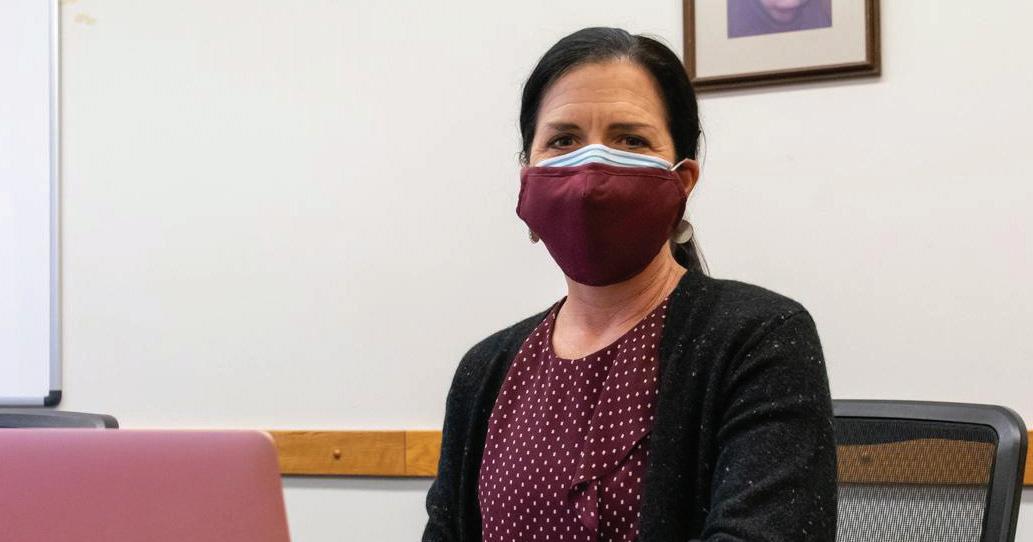
himself, teaches immigration law at UO’s Knight Law Center. He predicts the DACA program will end and be ruled unconstitutional by the Supreme Court.
“I don’t think DACA is long for this world. I hope I’m wrong, but it just doesn’t look like that,” Sati said. “Especially with this push toward mass deportations, I think that [rescinding DACA] is going to be the kind of thing [the Trump administration] will push to do by any means necessary.”
Sati also discussed new everyday challenges that could impact international students. For example, if students were unable to receive a social security number, they could not legally hold a driver’s license.
Driving without a license could result in arrest and a subsequent deportation would be more likely if Project 2025’s guidelines for Immigrations and Customs Enforcement to “stop ignoring” smaller local crimes is followed.
According to Howald, the “university office is strongly committed to providing ongoing support for all [of UO’s] international students, from visa issuance before arrival, to graduation and through all the moments in between in their journey at UO.”
(ABOVE) Global Studies Associate Professor Kristin Yarris is a leader in UO’s Dreamers Working Group. She said that she’s heard concerns from students regarding how the Trump administration will affect them.
(Molly McPherson/Emerald)
Disagreements over wages and more prevail on the table and in the streets as United Academics and UO’s Student Workers union head to mediation
By Sasha Love Campus News Reporter
As winter term begins, both UO Student Workers and United Academics are headed to state mediation and eyeing potential strike options.
During fall term sessions, the university and union bargaining teams found it challenging to agree on salaries that satisfied UO faculty. Disagreements over free speech and grievance articles, a focal point of UOSW rallies, also remain unresolved.
University of Oregon’s local Service Employees International Union 503 and the Graduate Teaching Fellows Federation supported UOSW and UA through tense negotiations and vow to continue their efforts into the winter term.
UA negotiators are striving to reach a contract that provides 8.5% pay raises for all faculty during 2025. At the final open bargaining session on Dec. 5, 2024, UO proposed a 4% raise for 2025 instead of their initial 3% offer, but UA did not accept this deal.
“We knew for months that [a] 4% [raise] for 2025 was going to be on the table … that is not sufficient for our members … It looks like a raise on paper but it is asking us to swallow a pay cut because of inflation,”
Keaton Miller, associate economics professor and UA treasurer, said.
Across the board, faculty who did not receive merit raises saw their salary fall about 5% behind inflation during the timeframe of the previous contract from 2022 to 2024, when faculty compensation is compared to the most current Consumer Price Index.

For tenured professors and those on a career and tenure track, that pay gap was partly or fully closed if their work met certain standards after review processes.
The university offered UA higher merit-based raises in addition to the 4% across the board raises, but UA refused the package.
Chris Meade, UO director of employee and labor relations, argued across the board raises are not the only way for faculty to gain adequate compensation.
State funding to UO is also a factor for how raises are proposed. Oregon Governor Tina Kotek’s proposed budget for 2025 to 2027 gives an approximately $4.39 billion boost to higher education in the state, but college and university leaders say it’s not good enough.
UOSW negotiator Izzie Marshall said there has been increased membership since UOSW bargaining began in February 2024, as more student workers choose to have a say over their wages.
While pay increases are important to UOSW, another priority is a free speech and protest article.
“So many student workers had free speech in the top three [ranked priorities]” Marshall said.
This debate over free speech comes amid concern over campus surveillance measures, which some union leaders described as “extraordinary” in a recent letter delivered to President Scholz.
UOSW’s proposed free speech and pro-
test article requests that the university not use law enforcement unless there is a “clear and present threat of danger and with advanced notice to all parties involved.”
The result of bargaining and mediation remains up in the air.
“We are fighting to make the changes that will change not just our lives as student workers but also all the student workers to come — years from now,” Marshall said.
Given the possibility of strikes if mediation does not resolve conflicts, unions across campus are preparing to show up for each other.
“We stand in solidarity with our fellow unions on campus and we will take their lead,” Chris Chase, SEIU outreach coordinator and UO data assistant, said. “We are obligated to show that solidarity.”
UO has decided that across-the-board raises for faculty is not the smartest way to divide the pie. According to Meade, the university is already in a “challenging fiscal citation,” lacking the money it needs to fund education and general expenses this year and over the next five years.
That said, many campus workers continue to feel discouraged and strive for higher wages.
“We are human beings; we are not just line items on a spreadsheet … people have dedicated their lives to this work,” Miller said.







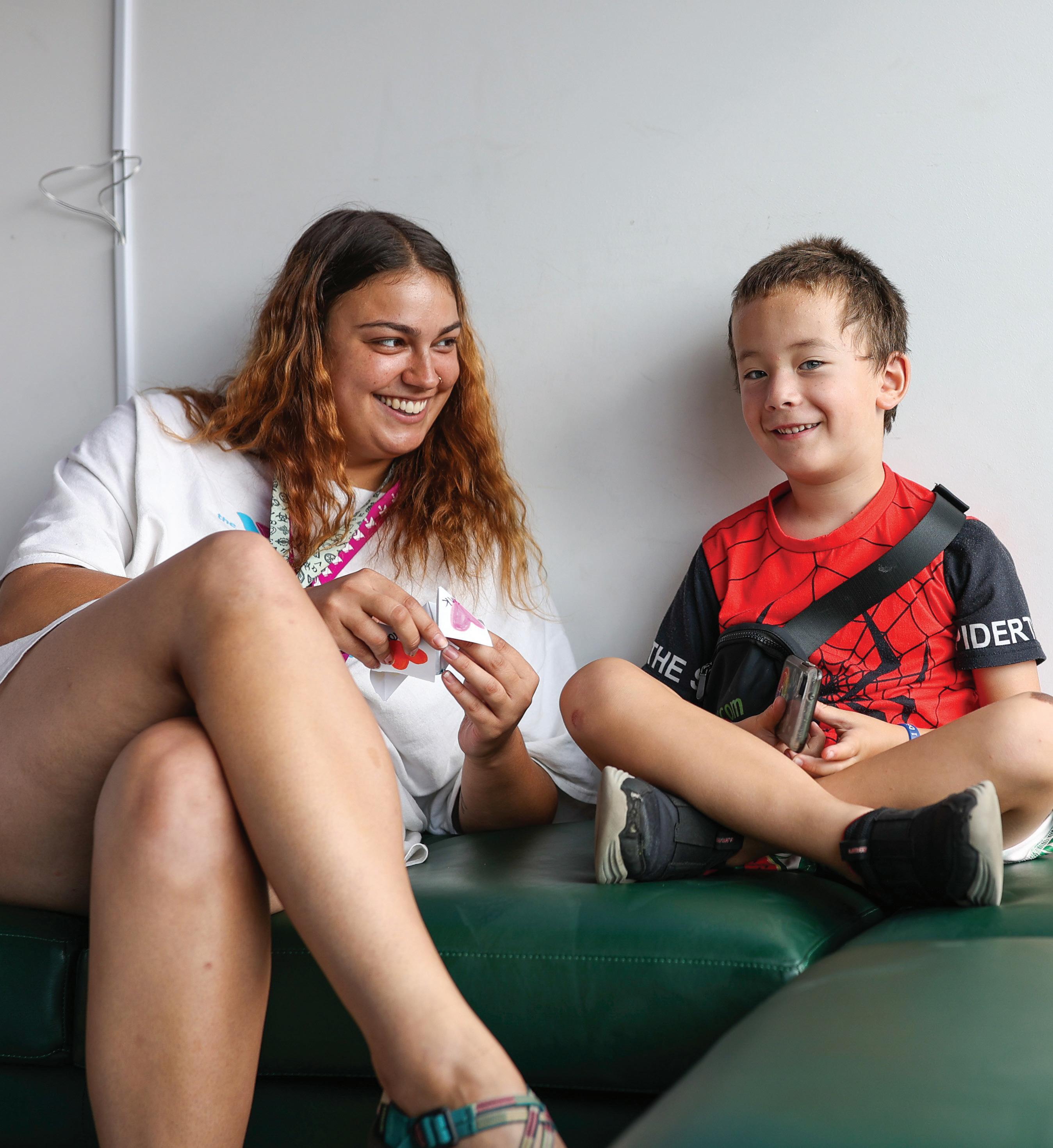






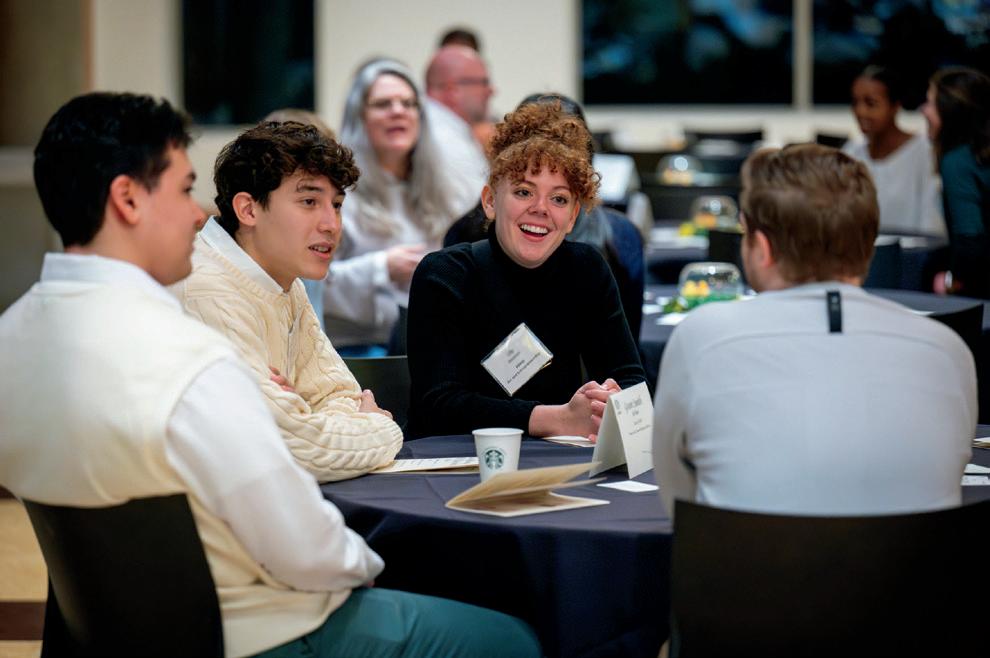
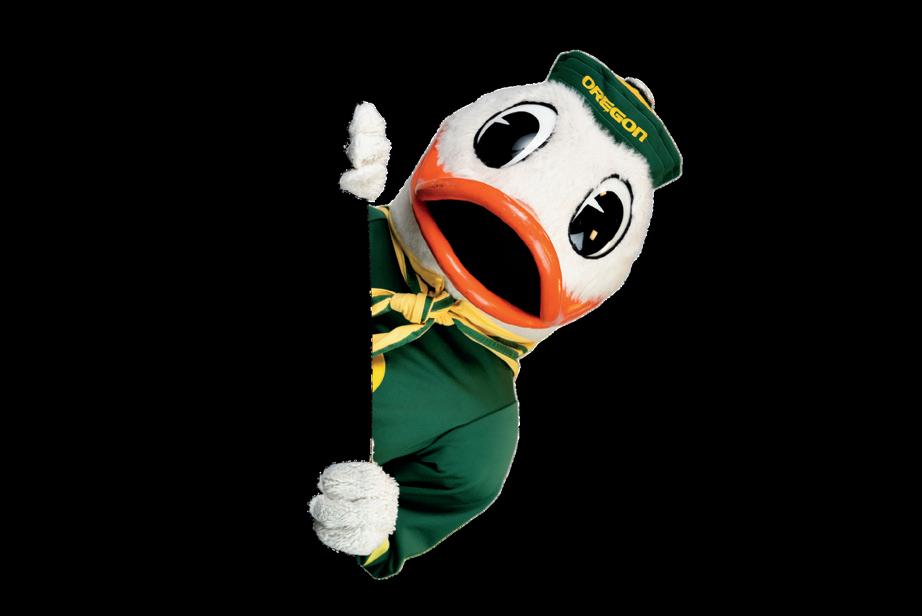






due to a lack of bike lanes and multiple dangerous junctions.
The new intersection includes the addition of dedicated turn lanes for all left turns to prevent drivers from turning into oncoming traffic. The project also added protected bike lanes, widened roadways and upgraded sidewalks.
The renovation added red, raised truck aprons, which are raised areas in the road that provide larger vehicles more room to navigate turns without hitting the curb. In this case, they also encourage drivers to take considerably slower, sharper right turns when navigating around the aprons
on curb corners.
Marion Barnes, public affairs manager for City of Eugene Public Works, said that the expectation is to slow down right turns, provide better lines of sight and eliminate the “right hook” crash that occurs when drivers turn right and collide with a pedestrian or biker with the right of way.
In the city’s Vision Zero Action Plan adopted in March 2019, the intersection at River Road and Hunsaker Lane was identified as a high-crash location. Many driving, biking and pedestrian-related deaths or injuries were shown in the reports according to Oregon Department of Transportation crash data from 2007 to 2015.
However, some residents have had trouble with the raised truck apron corner, with complaints deriving from the additional barrier.
“You can’t see that [the curb] is raised when you’re driving toward it until you go over it,” Emily Nelson, a DariMart employee, said. “I think it was kind of pointless. I think it was just a waste of money on things that could have been fixed in different areas.”
Barnes said the most complaints she has received are from drivers and people having trouble with the raised truck apron corner. However, she emphasized the importance of speed helping to reinforce the safety of pedestrians, bicyclists and drivers.
“Slowing down is the number one way to keep people safe. It is always speed that causes these accidents, so we just need people to slow down, turn a little more sharply and stay in their lane,” Barnes said. “Nobody likes to be
told to slow down, but slower is safer.”
During construction, modified traffic control and pedestrian access routes were implemented and the city urged commuters to exercise patience when traveling through the area during the period of construction.
The project caused some frustration among people in the area as large equipment occupied space during construction and impacted traffic patterns.
Barnes said that the protected intersection will serve as an example and expects it to take some getting used to.
“We’ll give it some time and then we’ll go out and probably do a community survey in that area and see how people think it’s working,” Barnes said.
Looking ahead, Barnes said the city will make more improvements to Hunsaker Lane such as adding sidewalks and refining the groundwork and safety of the protected bike lanes at this River Road intersection. Those bike lanes will eventually connect to the Ruth Bascom Riverbank Path System that runs through Eugene.
“We needed that [River and Irving Road] intersection to sort of join these two areas of bike paths in a safe way that previously hadn’t been joined together,” Barnes said. “So this is one step in this bigger picture project that’s bringing more active transportation to that northern River Road area.”
Flu season in the winter is not just for humans. Birds have their own variation of the illness to worry about, and Eugene’s Cascades Raptor Center has protocols in place to help combat the disease.
By Hanna Kalan City News Reporter
The Eugene Cascades Raptor Center has been caring for a variety of bird species since 1990. Just 15 minutes south from the University of Oregon campus, the center is a non-profit organization that offers tours, education and has a hospital to help treat sick or injured raptors.
The center has 30 birds that they call “educational ambassadors.” These birds will remain at the center for the rest of their lives.
“There are a few different ways these birds come to us to be educational ambassadors,” volunteer Sofia Bajenaru
said. “Some of the birds were injured… something about them that means they are unreleasable, another way a bird may be unreleasable is if they have imprinted on humans.”
If a bird imprints on a human, it becomes dangerous for both the bird and for people because the bird becomes too comfortable around humans. Oftentimes, this means the bird cannot hunt or take care of themselves. Bird imprinting typically occurs from “well-meaning but misguided choices to try and rehabilitate the birds themselves,” Bajenaru said.
As humans begin to get vaccines to combat the flu, birds soar into a flu season of their very own.


“Avian influenza is kinda like human influenza where it changes from season to season,” Jennifer Appleby Chu, the visitor services coordinator for the center, said. One of the main differences between human and bird flu is that avian flu is fatal for birds and, for the time being, there is
The illness follows migration patterns of birds that are commonly found near water, scientifically known as waterfowl.
“Waterfowls are the biggest carriers of the virus because they are not always affected by it, they also congregate in huge numbers, travel long distances, they can contaminate large bodies of water with the virus,” Appleby Chu said.
Some bird rehabilitation centers will not take waterfowl during the flu season be-
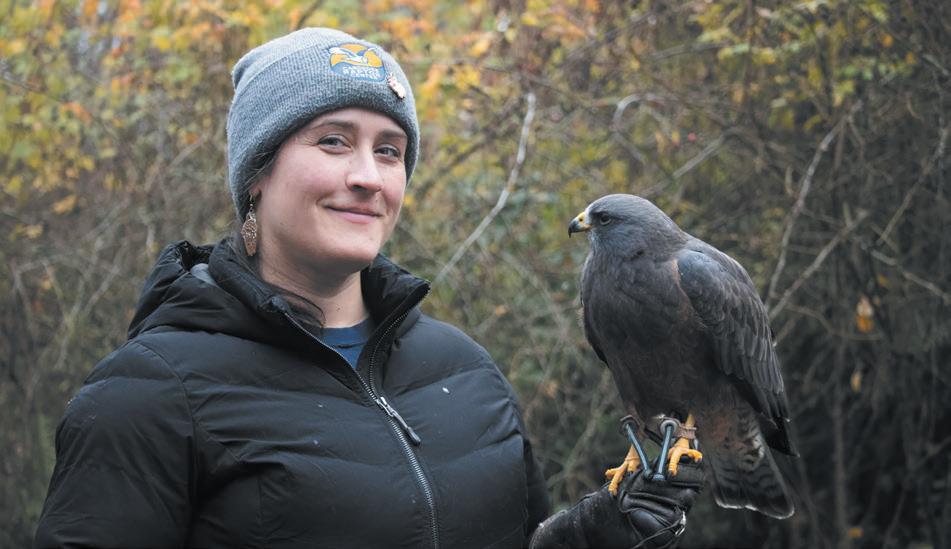
cause of the potential risk.
“We think about its effects on our facility; what are the ways this could get tracked in here and how do we prevent that from happening,” Appleby Chu said.
The facility only lets essential staff inside the hospital building. Each staff member that enters must soak their shoes in water and disinfectant footbaths. A lot of staff, including Appleby Chu, have shoes that are only worn at work.
The symptoms of the flu vary for every bird but they can include discoloration, drooping wings and sudden death.
“It is a virus that is constantly evolving and mutating just like any other organism, this year we are seeing it affect animals it wasn’t before, it has been found present in domestic cattle and occasionally canines,” Appleby Chu said.
“The Supplemental Nutrition Assistance Program (SNAP) is a Federal Entitlement Program that provides monetary food assistance to individuals and families with low income.”
According to UO’s website, students are eligible if they are enrolled at least “halftime” (six credits for undergraduates) and meet specific income requirements and other criteria. “An individual can receive a maximum SNAP benefit of $292/month.”
SNAP can be used for more than just groceries. Some additional benefits include: Agate Street Market
Double Up Food Bucks Ordering Food Online Internet and phone services Home Energy assistance program
Bike Rentals
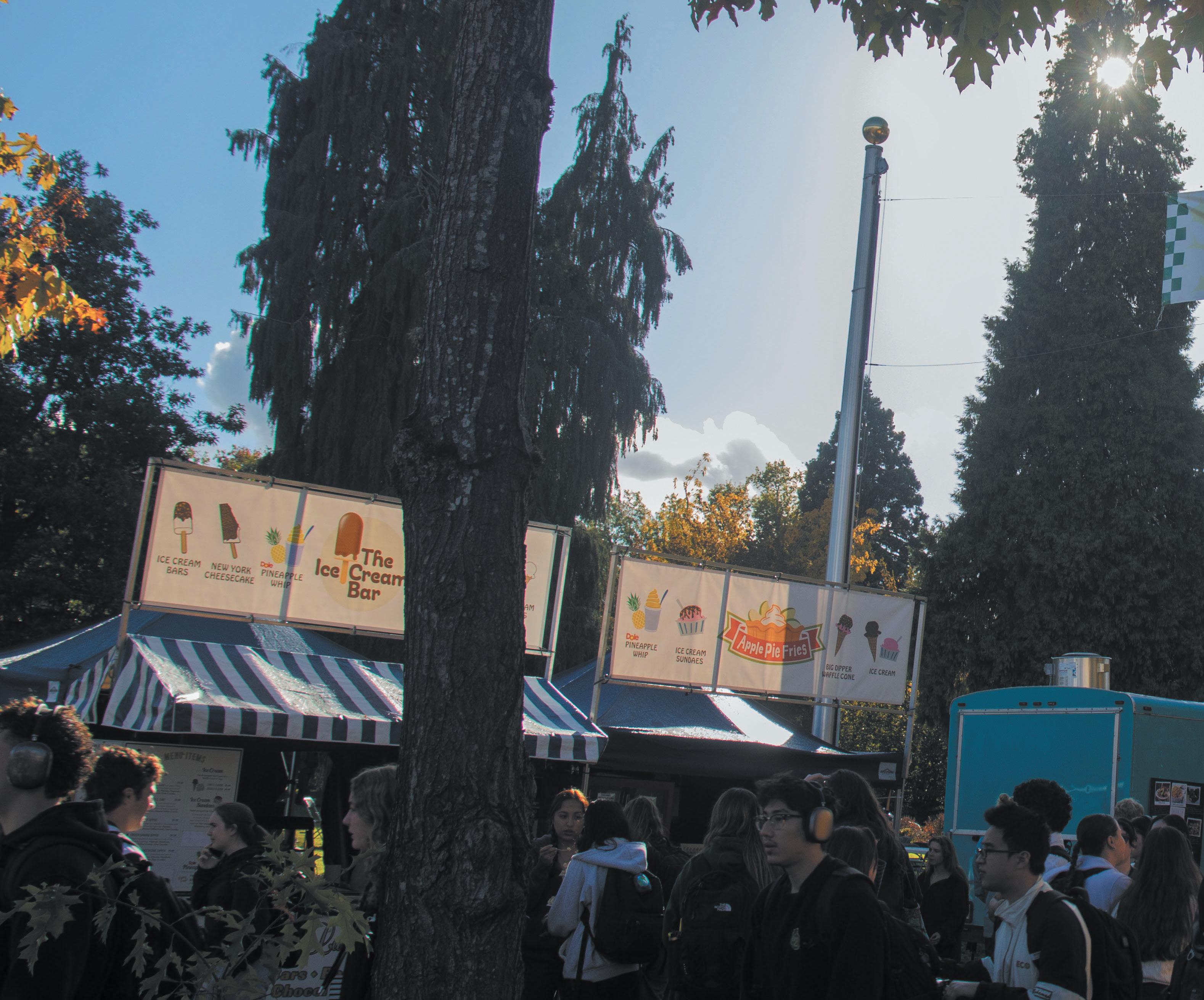
funds for student groups, to providing resources for club leaders,” each elected member holds the responsibility “to support all UO students.”
Working alongside Akpakwu is Mariam Hassan, the president of ASUO. They both serve on ASUO’s Executive Branch, which allows them to approve, oversee and work with over 200 student organizations across campus. Akpakwu addressed a series of questions relating to her priorities for the term, challenges she anticipates and more.
What were your primary goals for this term and how are they going?
force Stabilization Act in Salem.
We also are just trying to create … the SNAP map, so it’s a map of pretty much grocery stores within the Eugene area that accept SNAP. Hopefully it will be a resource for students who have SNAP and want to know which grocery stores will be able to serve them.
When you’re lobbying on a federal level, it can sometimes take months, if not years, to kind of get the stuff that you want to the floor. That’s been something that we have been working on extensively over the course of this year, and it’s going at a great rate, and hopefully, we’ll find out by the end of the year where legislators are with our basic needs package.
Visit basicneeduoregon. edu/snap to learn more
Akpakwu: [In] our administration this year, one of the primary goals that we’ve had is advocating for basic needs. So, I’m really glad and happy to say that a lot of the work that our cabinet has been doing has been lobbying to increase SNAP [Supplemental Nutrition Assistance Program] eligibility. We’re actually going to be going to Washington, D.C., in March, and that’s one of the things that we’re lobbying for. And we’re lobbying for the Basic Needs and Work-
What are your main priorities for the rest of the term?
Akpakwu: We have some things in store which I’m excited about. So for one, we’re going to be going up to Salem quite a bit to lobby for specific initiatives. We’re in our long session in just legislation right now, which means for a lot of the big new policies, initiatives, acts and reform
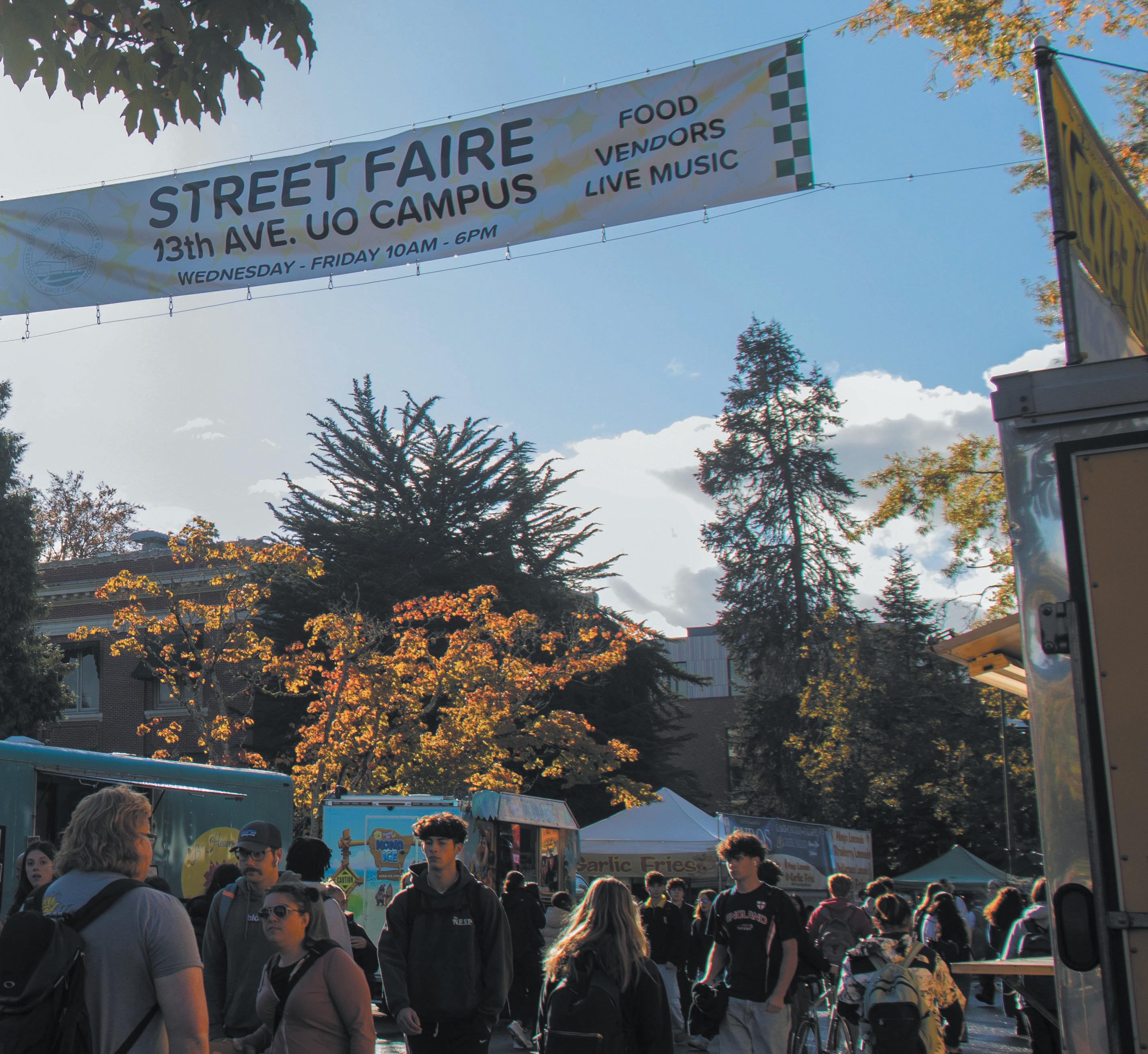
packages that people want to introduce. This is the year when legislators will look over and decide if they’re going to go with it or not. So, we’re going to be doing a lot of that with higher education funding, especially, and basic needs. The basic needs package and the Clery Act are some of the things that come to mind.
Akpakwu: We are going to be having a lot of tabling events, we’re going to be doing a hot chocolate bar, [and] we’re going to be doing a healthy parties event and a DIY bouquet-making. The Winter Fest on March 8 is one of the bigger events that we’ll be hosting, so we have a lot of great events coming up. The Spring Street Faire is something that ASUO does every year, and potentially the Spring Festival, which is most likely going to happen in late May.
Akpakwu: The biggest concern that comes to mind at the moment would definitely just be higher education funding on a federal level, and whether that’ll be cut or not. We’re kind of in a tedious place to see what we will have to do if higher education funding is cut. If [legislators] don’t support the basic needs package, then things could get a bit more tedious in terms of ASUO having to try to find ways to fund basic needs, the food pantry, transportation and housing subsidies.
It would become a little bit more complex to maneuver how we can spread the money that way if we don’t get it from the federal or state level. With that type of concern, the most we can do is hope for the best and potentially plan for the worst. That is something that we definitely have in our mindset.
What have you learned last [term] as ASUO Vice President that you will apply to the final months of your term?
Akpakwu: I think that this upcoming year, I have come to realize that the more people involved, the better in any situation, the more voices at the table and the more involvement from students who are non-ASUO members. I’m just going to really seek out input from a lot of different people [regarding] different policies that we enact and we try to do over the course of this year. I think just bettering representation and collaboration is something that I’m excited to emphasize in my work as vice president.
“The Basic Needs Program in the Office of the Dean of Students is here to connect you with campus and community resources intended to support your well-being, so that you can meet your academic goals.”
Student Food Pantry:
Hours: Wednesdays and Thursdays, 4:00–6:00 p.m. (during fall, winter, and spring terms)
Location: 710 E. 17th Ave., Eugene, OR 97401
Trillium Produce Plus Produce Drop:
Hours: 2:45 p.m. on Tuesdays until produce runs out
Location: EMU amphitheater
Leftover Textover:
“The Leftover Textover program alerts current UO students via text message when leftover, free food is available on campus. These leftover portions come from campus events where food was ordered from UO Catering”
“Students who opt-in to the program will be sent a text 15 minutes in advance of the leftover food being set out, with a location link provided on the UO campus map”
Students must bring a container for food
Students can sign up at foodsecurity.uore gon.edu/s/signup
Winter Textbook Subsidy:
Students can apply “to receive up to $150 toward textbooks or any required course expenses”
Applications open at 10:00 a.m. on Monday, Jan. 6, 2025, and will close when funds are used or on Friday, January 24, at 4:30 p.m., whichever comes first.
UO Housing Subsidy:
“The Housing Subsidy provides funding to help stabilize UO students experiencing housing insecurity. The subsidy aims to keep students in housing by preventing eviction and/or help ing students secure housing when finances are a barrier.”
“In order to be considered for a Housing Subsidy, students must first meet with a representative from the Basic Needs Program to collaboratively develop a basic needs stabilization strategy.”

Lexi is an opinion writer for the Daily Emerald. She is a second-year student studying journalism and psychology. Lexi enjoys writing about social topics such as pop culture.
By Lexi Smith Opinion Columnist
As students return to school for the remaining winter months, social scenes typically slow down.
The excitement from football season decreases and winter weather forces students into a sink-orswim mentality.
Winter term can become depressing, but forcing yourself to leave the comfort of your bed is important for your education and emotional well-being. Finding things to do can be difficult, but with some effort, the Eugene area has events to look forward to even during the winter.
For those looking for a weekly fun event, Elks Lodge in Springfield hosts line dancing every Tuesday night. Line dancing and swing dancing lessons take place from 7 to 8 p.m. Then, from 8 to 10 p.m., open social dancing is on the agenda for people of all ages.
University of Oregon sophomore Connor Jaffe took up line dancing as a hobby last year at Elks Lodge.
“They [Elks Lodge] have a variety of different kinds of music, so I’d say it’s pretty beginner-friendly. Some of the line dances are easy enough that you can just watch and learn,” Jaffe said.
During winter term, I favor indoor events which are more practical due to the weather which makes line dancing a perfect winter activity.
Along with weekly line dancing, some local venues will also host exciting events during the winter months this year.
Having fun during winter term takes more effort
“Harry Potter and the Goblet of Fire in Concert” will come to Eugene on Jan. 17-18 at the Hult Center. With tickets starting at $55, a live orchestra will perform iconic songs that are sure to be exciting for any Harry Potter fans in the Eugene area.
In addition, Gregory Alan Isakov will perform at the McDonald Center in Eugene on Jan. 27, at 8 p.m. Ticket prices vary from $49-$69 and this event is open to people of all ages who enjoy indie, folk music.
Concerts are a great way to fill up a quiet weekend during winter term. These types of events give students something to look forward to which helps the depressing demeanor of the winter term go by faster.
For those who enjoy local music, house shows are always fun to attend on weekends. Local bands which typically consist of UO students get together and perform at a house nearby campus.
These events are typically posted on the band’s individual Instagram pages, with the show’s date, time and address.
House shows are usually outside which isn’t ideal during the winter time, however, entry generally costs less than $10 and the shows are a great place to meet new friends.
One confirmed house show is the So Much Love Valentine’s Day-themed show.
SML is a growing brand that highlights local bands through artwork on merchandise. They host at least one house show every term and so far the events have been beyond successful.
Spencer So, founder of SML, is also a photographer at the Daily Emerald, however, he did not have any editorial contributions to this article.
“ So Much Love is a multi-platform creative endeavor,” So said. “It’s kind of like a loose fitting statement just so we don’t box ourselves in, but the goal is to spread love through experiences and create a community of people.”
So explained that the next SML show will be held at the Graduate Hotel in Eugene on Feb. 22. The official time of the show and future events will be announced on their Instagram, @ somuchlove.design.
The winter term can be tricky to navigate when finding social events to attend due to the weather conflicts, however, with some effort and preplanning, the winter term can still be fun.

“I’ve just had no motivation this semester”
In a climate known for getting cloudy and grey every year, why do we get so tired and sad in the winter? And how does the university help?
By Milly Gamlen Opinion Columnist
Winters suck for a lot of people, especially Oregonians. They can get sad, cold or simply lose motivation. The phrase I seem to hear most is “My seasonal depression is starting to hit,” but what does that mean?
Seasonal Affective Disorder (SAD), or its more commonly used name, seasonal depression,
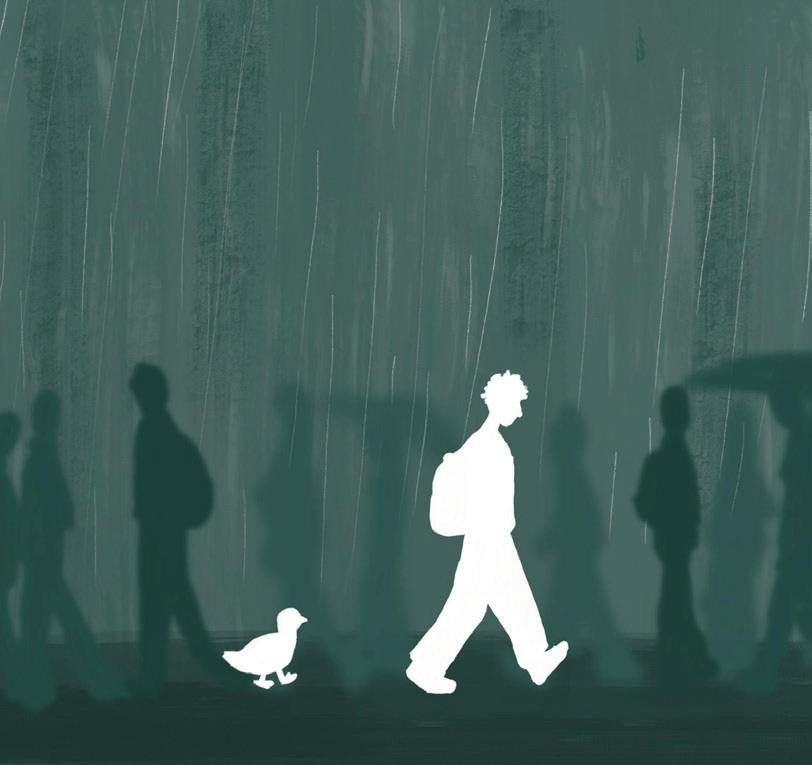
is something that impacts 10 million people in the United States each year. It occurs when the weather gets colder as a response to the shorter days and less sunlight. It also has links to melatonin, the hormone the body creates to regulate sleep cycles. Our bodies produce more during colder months, creating tired feelings more than in the summer.
It also impacts people in colder climates more intensely. So, it makes sense that students in Oregon would be more impacted than in places like Southern California or Florida. At the University of Oregon, roughly 57% of students are out-ofstate and, if you’ve met many of them, a large percentage are from California.
Keeping all that in mind, it isn’t a jump to say that many of the students at UO may not have ever experienced SAD to the extent they do while studying here. So, what does the university do to help them.
The University Health Services website has an entire page dedicated to mental health resources. It has links to counseling services and numbers to call along with opening hours.
What isn’t clearly displayed, however, is information about where to go for specific disorders. But, if one were to search “University of Oregon Seasonal Affective Disorder” something does
pop up. It is a calendar with an event about coping with SAD. However, there is one problem. The event is on Jan. 22, 2018.
There is up-to-date information on depression on the website, but the two disorders are not the same.
In a university where thousands of students come from out-of-state, where the annual tuition is just over $16,000 for in-state and over $44,000 for out-of-state, why are these students not getting access to resources that could seriously help them in the winter months?
I’m not saying that there needs to be an entire team created for SAD, but annual workshops instead of one nearly seven years ago might help. Mental health is something that studies show as many as 70% of college students struggle with. Even if not all of those students are impacted by SAD, that is still over half that might benefit from some help understanding how to better cope with it.
It is time UO started looking at more workshops to help with the transition from beautiful Eugene summers to the cold winter months.
If you or someone you know is struggling with SAD there are resources to help, even something as simple as talking to a friend might be helpful to you. There is treatment that can help.

Milly is a senior at UO majoring in Journalism with a minor in Sustainable Business. She has been writing for the opinion desk for three years and likes to write articles about drugs, politics, and societal issues.



Y u g o E u g e n e S k y b o x + Y u g o E u g e n e C o u r t s i d e

R A T E S S T A R T I N G A T $ 9 0 9
2 , 3 , + 4 B E D H O M E S F O R F A L L 2 0 2 5
( 5 4 1) 7 3 5 - 9 0 12
14 2 5 V illa r d S tr e e t
E u g e n e , O R 9 7 4 0 3
S T A R T Y O U R A P P L I C A T I O N O N L I N E w w w . li v e s k y b o x . c o m




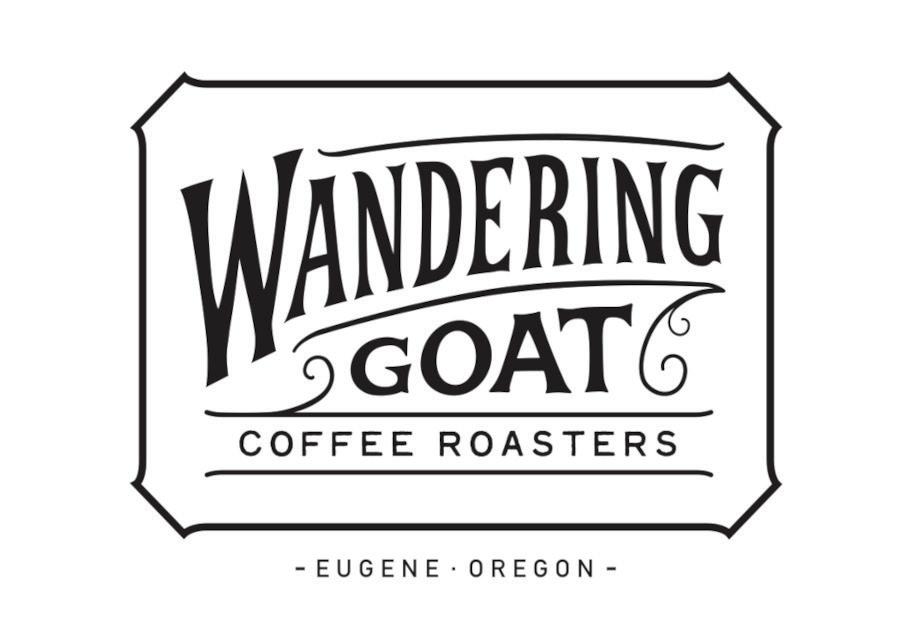
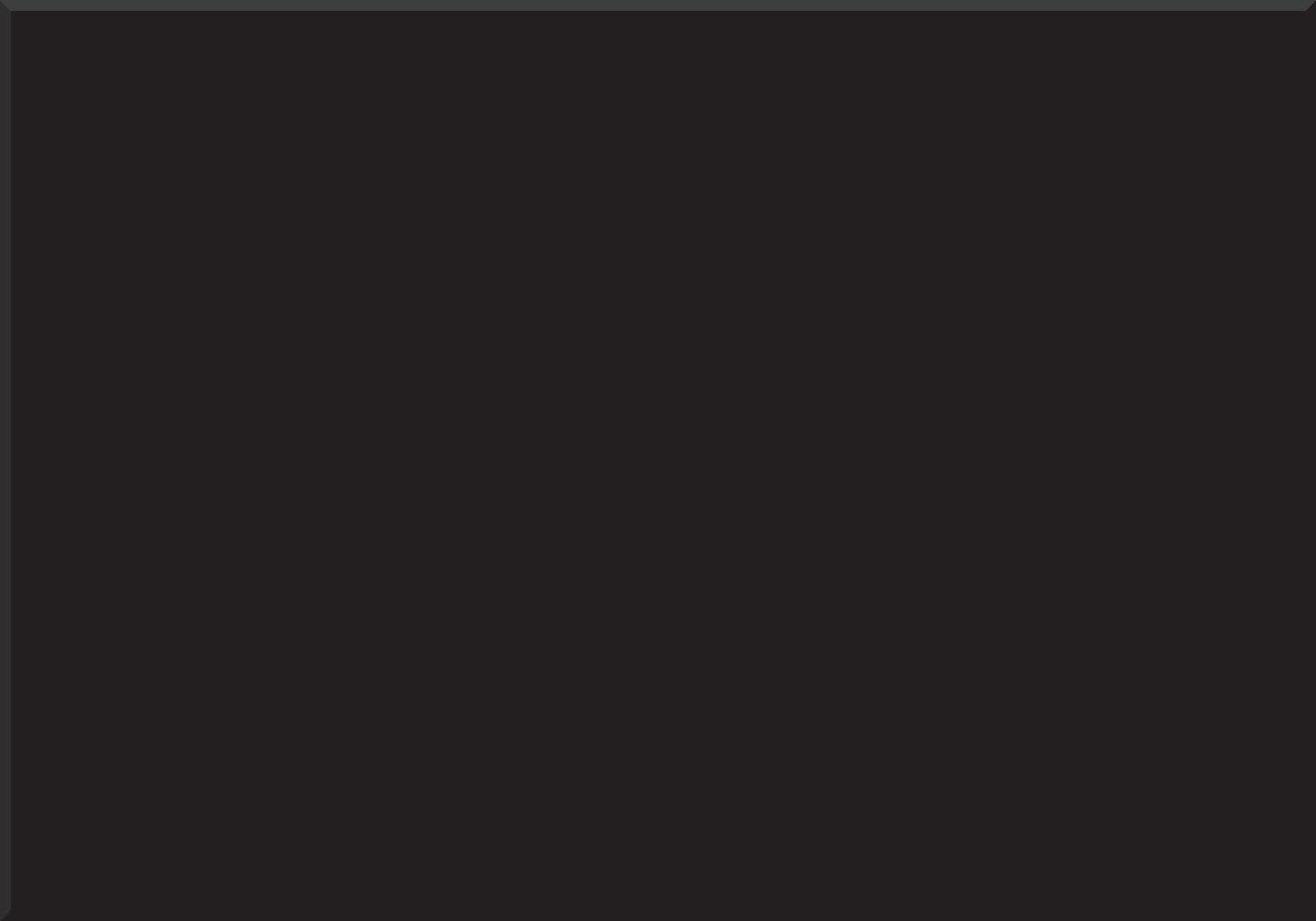

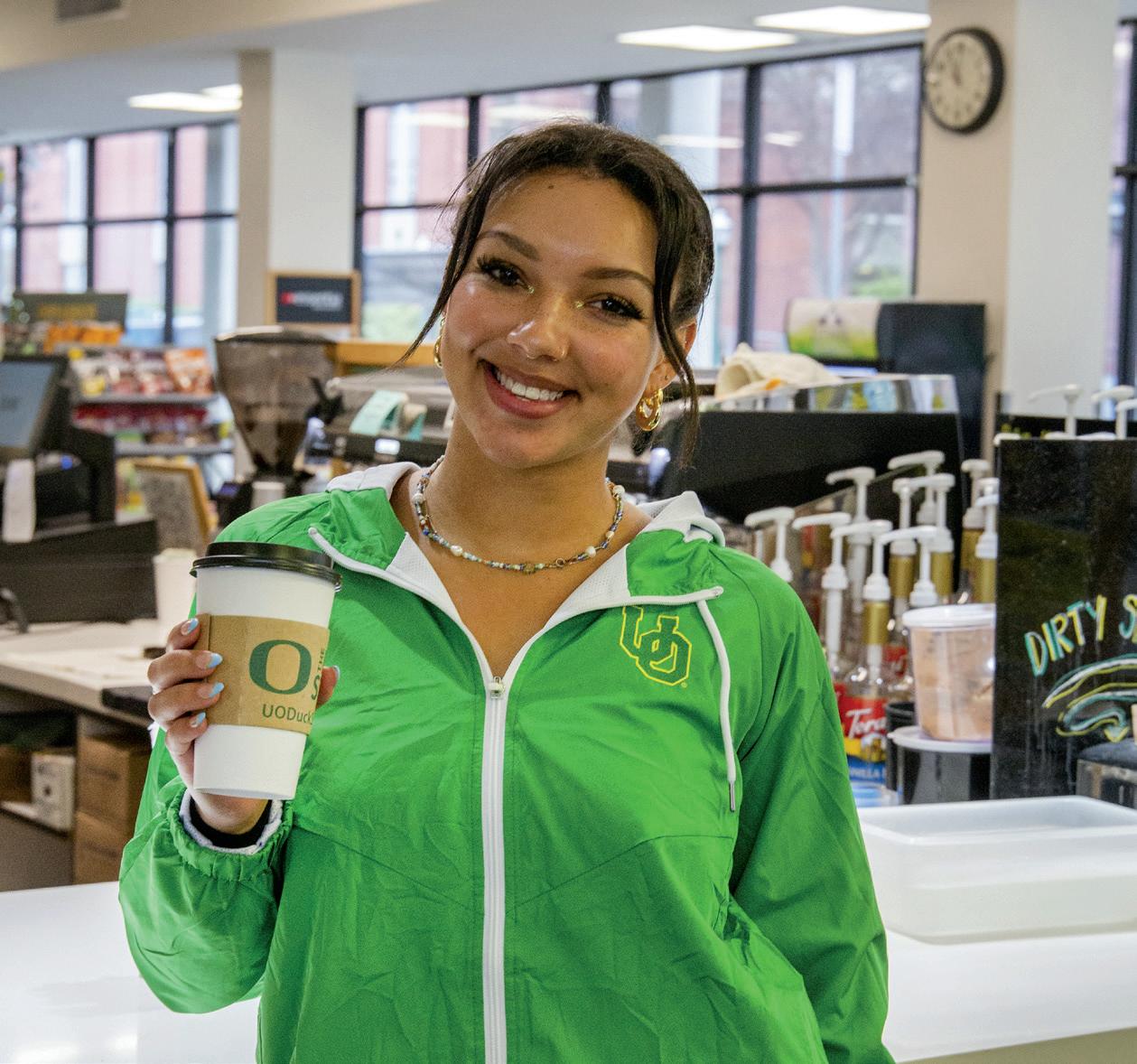
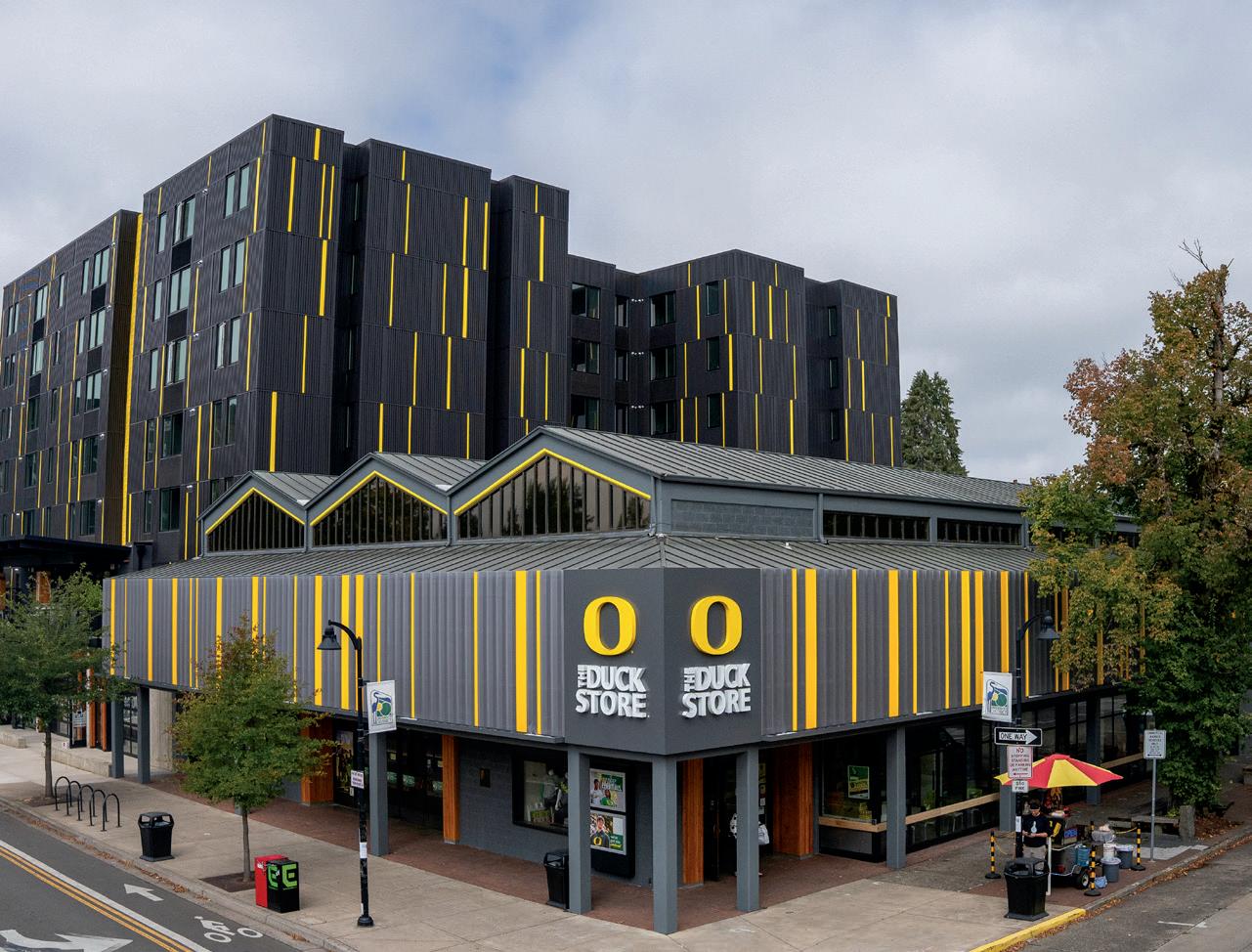


Learn how book editors, the backbone of the publishing industry, shape unpolished manuscripts into compelling stories. Their meticulous work ensures that every book meets high standards and resonates with audiences across the world.
By Bella Graham Arts & Culture Writer
The world of publishing runs on editors. They balance storytelling with language to craft all kinds of books from authors of varying skill. Editors are an integral part of the publishing process, and they can be the difference in whether a book gets published or not. Yet, their hard work frequently goes unnoticed.
“If an editor does their job well, readers won’t even know there was a middle man,” Sarah Currin, an editor and publishing professional based in Salem, said.
Editors make sure the final draft of a book is clear, correct and concise, keeping quality standards high in the publishing industry. The main purpose of the editing process is to ensure information is getting across to readers and that the content is being received in the intended way — the ultimate editorial goal.
The first part of the process is a reader’s response — the editor reads the manuscript and gives the author a five to 10 page report on what does and doesn’t work. The manuscript is heavily revised to fix the larger issues, proofing it for the second, more meticulous rounds of edits.
The second part of the process is developmental editing, which is larger scale story editing. An editor reads the whole manuscript, giving feedback similar to the reader’s report, but on a more granular scale. Developmental editing looks at different sections of the manuscript and gives overall feedback about characterization, world building and plot continuity, with specific notes on chapters or sections that
could use improvement.
After the developmental edit is line editing, which gets down into the nitty-gritty. Does each paragraph read well? Do the chapters flow? After line edits come the copy edits, which get into the minutiae. Are the commas in the right place? Does this period belong here?
Proofreading is the last editorial stage. The manuscript has already been designed, so the editing happens in a PDF or a printed copy. New edits cost money at this point, so editors aren’t looking for big picture issues anymore. Most edits in the proofreading stage will only be “fatal flaws,” like someone’s name being spelled wrong.
“I’m sure that sounds really boring, but the process of editing is something that I really love,” Currin said. “I’m always thrilled to have the opportunity to be able to take the raw material of a manuscript and be that intermediary who’s facilitating the reader getting the story they need.”
Although most editing jobs are concentrated in a few places (namely, New York City), it’s possible to work in cities further away from this hub. Portland has a great literary scene, and one that provides opportunities for literary editors.
“It’s a smaller city with smaller companies. They do amazing stuff, but they’re not Random House,” Currin said. “They don’t have unlimited budgets, they don’t have unlimited staff, but it’s still a great place to work.”
If an editor doesn’t want to work for a publishing company, there are freelance opportunities as well.
“I really love being able to work in a contract capacity with a lot of these really cool, smaller publishers who may not have been a good fit for me as a full time career choice, but

then I still get the fun of working with them,” Currin said. Learning the details of the editing process may paint editing to be a very solitary profession: the editor, the manuscript and a pen, just toiling away. But most editors agree the best editing is done in conversation with other people.
“It’s a lot of asking questions with each other. What is the overall meaning? What does the author hope the audience is going to take away? Why is this story important right now? What should readers remember over time?” Currin said. This level of collaboration represents how the publishing industry has remained a traditional one, not quick to change with the development of technology that could make editing a remote profession.
As a cornerstone of the publishing industry, editors play a pivotal yet often overlooked role, on purpose. This part of the publishing industry offers a variety of career paths to contribute to the world of storytelling. Editors shape manuscripts into polished books that resonate with readers across the world, and are behind the process that helps every book come to life.
inally opened at a different location in 1981 by Bob November and his lead salesman, Dick Gunn. November was diagnosed with cancer and passed away in 2012. His store has since been passed on to Artie Leider, who continues November’s legacy.
“Between the two of them, the depth of knowledge that they had is a dying breed of people because they experienced every era of classic guitar as it was happening,” Mike

Scheidt, a salesman and musician at the store, said. “They just had next-level abilities, and they knew what they were talking about.”
Scheidt had been coming to the shop since high school and he was hired in 1994 to help speak the language of the “metalhead” player base. Scheidt left the store to become a touring musician in the band YOB, but he was still able to come back to the shop to help out. In his time working with November, Scheidt learned and fostered skills that showed him how to draw guitars of a certain caliber.
“I’m not a virtuoso, but truly the style that I developed was from working here,” Scheidt said. “It’s just stuff I would have never learned like you wouldn’t have found me on a porch trying to learn Merle Travis if I hadn’t seen it in front of my face, marveled.”
Since McKenzie River Music moved to its new location in 2000, the landscape of the business has drastically changed. Stores like Sam Ash, Mars and Guitar Center were not as prominent of music stores as they are now, but Leider sets the store apart from the others with the level of expertise and education that they offer. Leider started buying and selling guitars when he was about 14 years old, and when he moved to Eugene in 2004 to start a family, he was immediately brought into November’s vintage guitar community.
“The philosophy of this store is that there are so many different types of people playing guitar and for me, there’s a place for everyone who walks through the door, whether it’s a touring professional or a kid finding their first guitar,” Leider said. “We try to find people the instrument that’s going to give them not only the most pleasure, but also fit their needs because with any tool, there’s a different tool for
a different job.”
In recent years, modern instrument manufacturers have been steadily growing and developing new technologies. The global musical instrument market was valued at $14.20 billion in 2022 and is projected to grow at a compound annual growth rate of 7.4% from 2023 to 2030. McKenzie River Music’s vast selection of vintage and modern guitars is not the only factor that sets them apart from the rest.
“There’s another gentleman who works here who’s a fantastic professional bass player, one who is a spectacular slide guitar player and has won numerous awards for it, and Charlie Longstreth doing repairs and making fan-fret guitars that are world famous,” Leider said. “It is about the collective people here, each one of them bringing something to the table, that adds up to it being a special place in an immeasurable way.”
McKenzie River Music has strived for and hopes to continue to foster youth involvement in music in Eugene by getting involved in Girls Rock and aiding local music teachers with what they need. Before COVID, Leider and the crew would host live events in the store to promote local professional musicians, and he hopes to start that back up again in the near future.
In Eugene, there is no place like McKenzie River Music, where you can find something for all types of guitar players, new and experienced, and receive the level of expertise and transparency they offer.

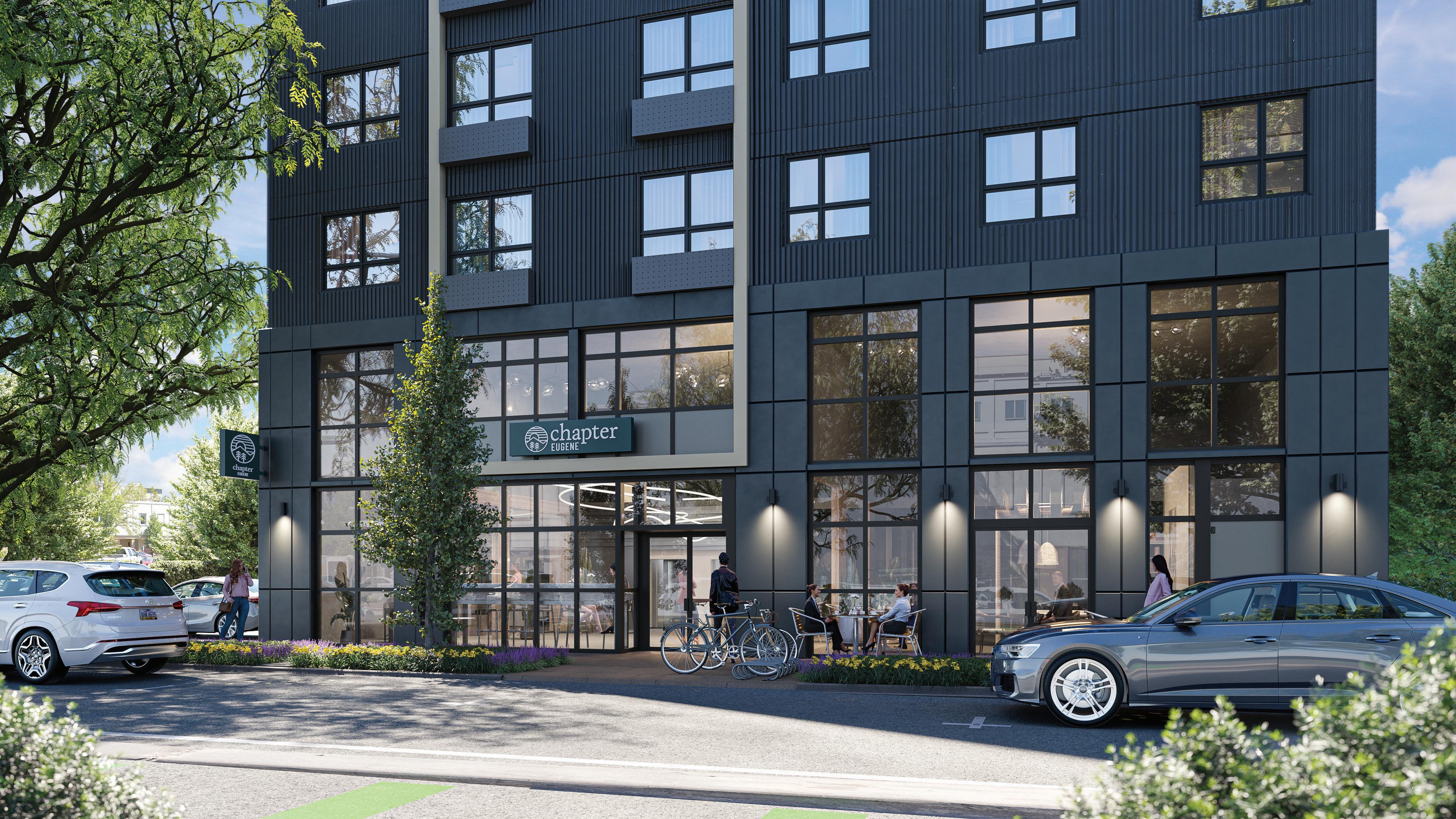



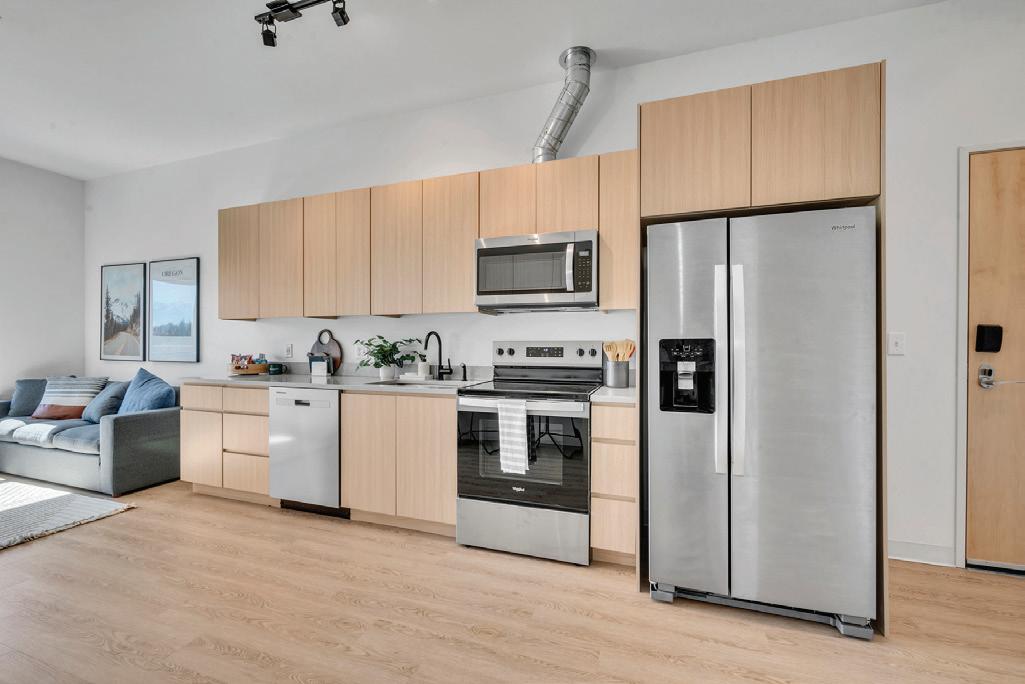
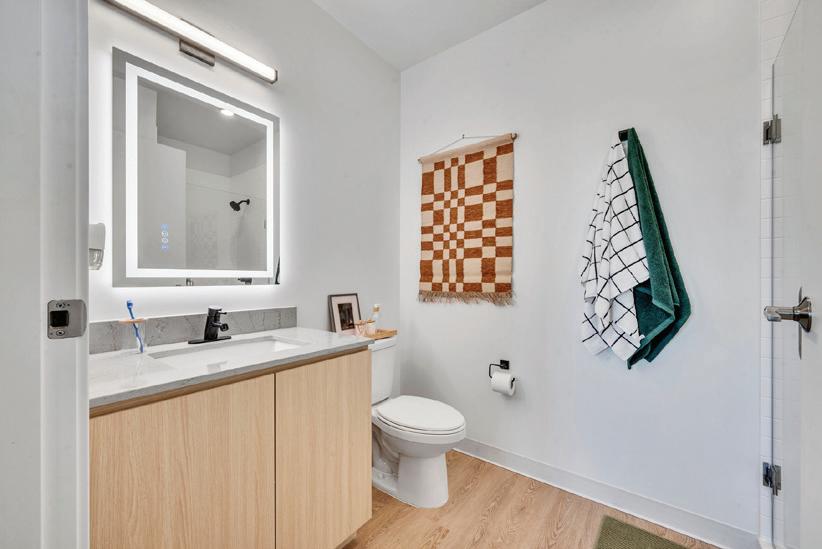



No. 9 Oregon hangs on to defeat Maryland 83-79 in

Defensive lineman Bear Alexander announces transfer to Oregon


By Beck Parsons Sports Reporter
To fans of the 2014-15 Ducks, Oregon’s 41-21 defeat at the hands of the Ohio State Buckeyes felt all too familiar.
In the 2015 National Championship, Buckeyes running back Ezekiel Elliott demolished Oregon’s defense on the ground, tallying 246 yards and four touchdowns to secure a 42-20 victory and ruin Oregon’s dreams of a national title.
Almost ten years later, in the 2025 Rose Bowl, true freshman wideout Jeremiah Smith put on a similarly game-breaking display. His seven receptions for 187 yards and two receiving touchdowns – all but 26 yards of which came in the first half – gave Oregon no chance to establish any defensive momentum.
“He attacks the ball in the air as well as any receiver I’ve seen,” Oregon head coach Dan Lanning said of Smith. “The guy’s NFL-ready, he’s that special.”
Smith, who stands six-foot-three and 215 pounds at just 19 years old, made his presence known immediately. Just one minute into Ohio State’s opening drive, Smith got the ball in his own backfield and blasted past two Oregon defenders for a 45-yard touchdown catch, effectively setting the tone for what was to come.
In the second quarter, Smith struck again. On second down at Oregon’s 43-yard line, quarterback Will Howard found a wide-open Smith for as easy of a touchdown as the
pair has had all year.
Howard was subject to criticism following Ohio State’s midseason 32-31 loss to Ore gon, in which he erroneously ran out of time while attempting to move his offense fur ther into field goal range. However, How ard slayed his demons in Pasadena, going 17/26 through the air for 319 yards and three touchdowns in what was maybe his best showing all season.
Also effective was Ohio State’s run game. TreVeyon Henderson carried the ball eight times for 94 yards and two touchdowns, including a 66-yard touch down on the first play of the Buckeyes’ sixth drive. Quinshon Judkins was solid as well, tallying 17 carries for 85 yards.
“They were clicking on all cylinders,” Lanning said. “We didn’t really have the ability to stop them.”
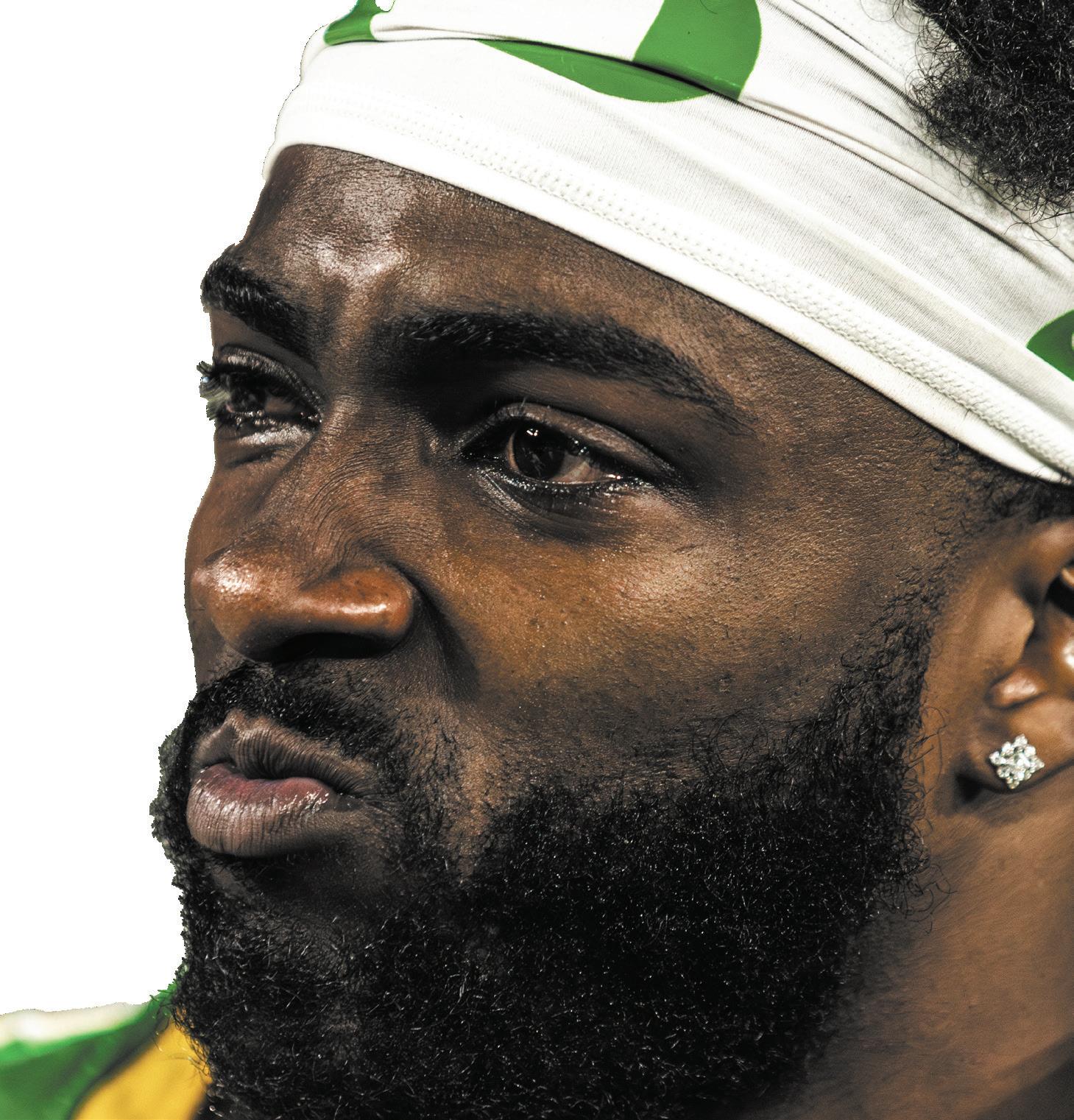
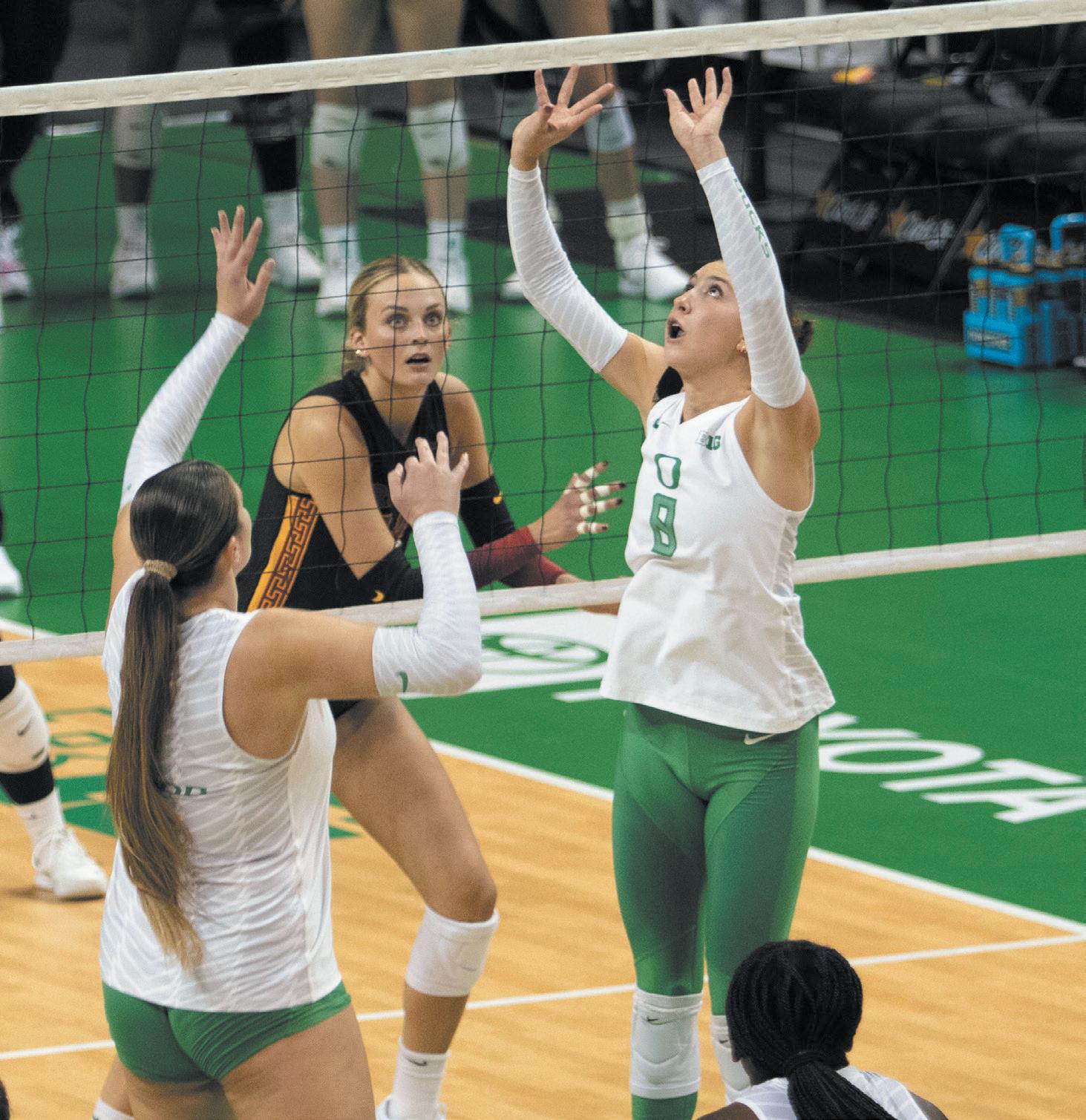
The Ducks’ underclassmen showed why the next couple of seasons are promising for the program
By Lily Crane Sports Reporter
Veteran players led Oregon volleyball in its 2024 season which extended all the way to the Sweet 16. When the Ducks’ season ultimately ended on Dec. 12, so did the collegiate careers of several of their most formidable players.
Head coach Matt Ulmer will likely recruit some big names from the transfer portal this offseason, but if there’s anything the final stretch of the season proved, it’s that Oregon has several young players ready to step into the spotlight.
Noemie Glover was one of the Ducks’ leaders in its NCAA Tournament run. In only her sophomore season, Glover was third on the team in blocks per set, third in block assists and fourth in total kills.
With Oregon graduating big contributors in Michelle Ohwobete and Onye Ofoegbu, it’ll require Glover’s role to increase next season.
Glover showed she’s up to the task, as she played her best volleyball at the end of the season. She recorded double-digit kills in seven of the last nine matches of the season, including a season-high 15 kills to go along
with six blocks against a ranked Purdue.
Another key cog in the Ducks’ future is setter Cristin Cline. She redshirted the 2023 season while she learned from former All-American setter Hannah Pukis.
Cline stepped into the starting lineup in 2024 and guided Oregon’s attack. She averaged over 10 assists per set and recorded 23 service aces over the course of the season.
The Ducks are also expected to return their setter’s favorite target: star outside hitter Mimi Colyer.
Having Colyer back for her senior season will give Oregon some continuity with lineup changes on the horizon. She’s been the team’s leader in kills for each of the past three seasons.
The program has come close the past three years but has yet to secure an elusive Final Four berth under Ulmer’s tenure. With the Ducks having one season of the Cline-Colyer connection under their belt and the rise of Glover’s production, the potential for another deep tournament run hasn’t gone anywhere.




